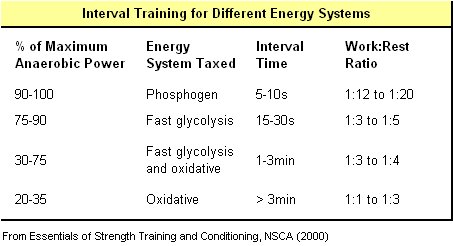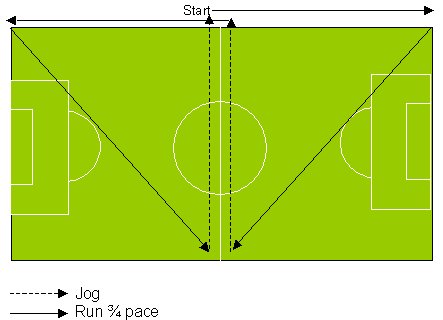Interval training can be best described as bouts of exercise interspersed with short rest intervals. It is based on the concept that more work can be completed at a higher relative intensity compared to continuous-type training.
The intensity and duration of the work intervals and the length of the rest periods dictates the training response. Very short, all-out bouts of work coupled with longer rest periods are used for speed and speed endurance development.
Short, very intense work intervals with short rest periods will predominantly tax the fast glycolytic energy system. Conversely, longer, lower intensity exercise bouts and short rest intervals can be used to develop aerobic endurance.

Rest intervals are a critical component of the interval training program design. From the chart above, you can see that in order to stress the aerobic system efficiently, short rest periods are incorporated into the session. The opposite is true for speed development.
Research has shown that long rest periods (i.e. 1:12) result in low concentrations of lactic acid accumulation is low, increases in stroke volume are minimal and improvements in VO2 max are not seen. The opposite occurs when short rest intervals (i.e. 1:1 or less) are adopted (2,3).
Very short rest intervals are associated with high levels of blood lactate accumulation. This effects neuromuscular control and can negatively impact speed development. Because speed training requires maximal effort and a high quality of work, longer rest periods are more appropriate to allow the athlete to recover between work intervals. In order to enhance aerobic endurance and increase VO2max towards its upper, genetic limit, interval training should consist of 3-5 minute work bouts with a 1:1 work to rest ratio or less. The intensity should equate to 90-100% VO2max (1). This would be suitable for endurance events such as distance running, swimming, rowing or cycling for example. It could also be used for endurance development in multi-sprint sports such as rugby.
Interval Training is Suitable for Many Sports
Nearly all athletes require a basic level of cardiovascular endurance, if for no other reason than recovery between intense bouts of work. Traditionally, coaches have opted for long, slow, distance training at 70-80% maximum heart rate.
The problem with this approach is that is not specific to many sports such as the multi-sprint games and can actually be detrimental to strength and power performance (4,5). Research shows that long, slow continuous training can actually decrease anaerobic / glycolytic enzyme activity (6,7,8,9,10).
For sports such as basketball, soccer, hockey, tennis, rugby and so on, interval training may be more appropriate than continuous running because it can increase aerobic power and improve cardiorespiratory endurance without the associated detrimental effects on anaerobic power.
However, its not only multi-sprint sports that can benefit from interval training. Performance in the more classical endurance-based events such as the 10k run or distance swimming can improved by incorporating higher intensity interval training even if its at the expense of some volume. Below are some sample interval training sessions.
Interval Training Sessions
As mentioned earlier, interval training can be incorporated into a wide variety of sport-specific training programs. While the parameters in the table above provide a suitable program guideline, drills and sessions should be made as sport-specific as possible.
Interval Training Sessions For 10-km Runners
The training sessions in the table below are designed to improve the oxidative energy system the most predominant pathway in this type of activity.

Interval Training Session For a Multi-Sprint Sport
The interval training session below is designed to improve cardiovascular endurance for a mutli-sprint sport such as soccer. Remember, that interval training describes only the format of training and is not only used for endurance development. Other sessions, using different work to rest ratios can be devised in order to develop speed or speed endurance.
Increasing Lap Run

Using the markings of a soccer pitch or similar size area, start on the touchline at the halfway point and run pace to the corner flag. Run pace diagonally to the opposite side of the pitch at the halfway point. Jog slowly along the halfway line back to the start. Continue for the other half of the pitch. This is one repetition. Repeat for 3 repetitions and rest for 2-3 minutes minutes. This is 1 set. Complete 3-5 sets in total for an interval endurance session.
Interval Training Sessions For a Tennis Player
Again, a sport like tennis requires elements of both aerobic endurance and anaerobic power. This interval training session below is designed to improve tennis-specific cardiovascular endurance.
Cross Court Drill
- Holding a racket stand at one far corner of the court (where baseline and doubles sideline meet).
- Side step along the baseline to the opposite far corner.
- Run three quarter pace diagonally across the court to the corner of the net. Make an imaginary forehand shot with the racket.
- Side step along the length if the net to the opposite corner.
- Turn and run at three quarter pace diagonally across the court back to the start. Make an imaginary backhand shot.
- Continue this sequence for 60 seconds then rest for 1-2 minutes. Perform a total of 5 runs to complete 1 set. Rest for 3 minutes and repeat for 2-3 sets.
References
1) Wilmore JH and Costill DL. (2005) Physiology of Sport and Exercise: 3rd Edition. Champaign, IL: Human Kinetics
2) Callister R, Shealy MJ Fleck SJ and Dudley GA. Performance adaptations to sprint, endurance and both modes of training. J Appl Sport Sci Res. 1988 2: 46-51
3) Kraemer WJ, Fleck SJ, Callister R, Shealy M, Dudley GA, Maresh CM, Marchitelli L, Cruthirds C, Murray T, Falkel JE. Training responses of plasma beta-endorphin, adrenocorticotropin, and cortisol. Med Sci Sports Exerc. 1989 Apr;21(2):146-53
4) Fox EL, Bowers RW and Foss ML. (1988) The physiological basis of physical education and athletics, 4th ed. Dubuque, IA: Brown
5) Gaesser GA, Wilson LA. Effects of continuous and interval training on the parameters of the power-endurance time relationship for high-intensity exercise. Int J Sports Med. 1988 Dec;9(6):417-21
6) Abernethy PJ, Thayer R, Taylor AW. Acute and chronic responses of skeletal muscle to endurance and sprint exercise. A review. Sports Med. 1990 Dec;10(6):365-89
7) Plisk SS. Anaerobic metabolic conditioning a brief review of theory, strategy and practical application. J Appl Sport Sci Res. 1991 5(1):22-34
8) Spriet LL. (1995) Anaerobic metabolism during high-intensity exercise. In Exercise Metabolism. (pp 1-39) Hargreaves M, ed. Champaign, IL: Human Kinetics.
9) Viru A. 1995 Adaptations in sports training. Boca Raton, FL: CRC Press
10) Viru A and Viru M. The specific nature of training on muscle: A review. Sports Med. Training Rehabil.. 1993 4(2):79-98

Jacky has a degree in Sports Science and is a Certified Sports and Conditioning Coach. He has also worked with clients around the world as a personal trainer.
He has been fortunate enough to work with a wide range of people from very different ends of the fitness spectrum. Through promoting positive health changes with diet and exercise, he has helped patients recover from aging-related and other otherwise debilitating diseases.
He spends most of his time these days writing fitness-related content of some form or another. He still likes to work with people on a one-to-one basis – he just doesn’t get up at 5am to see clients anymore.